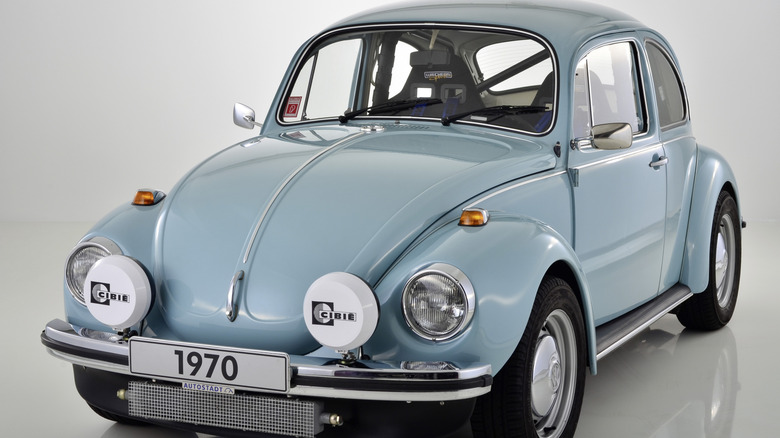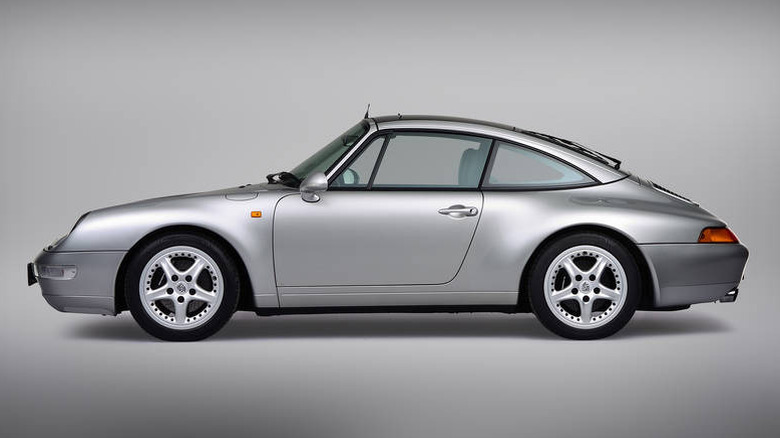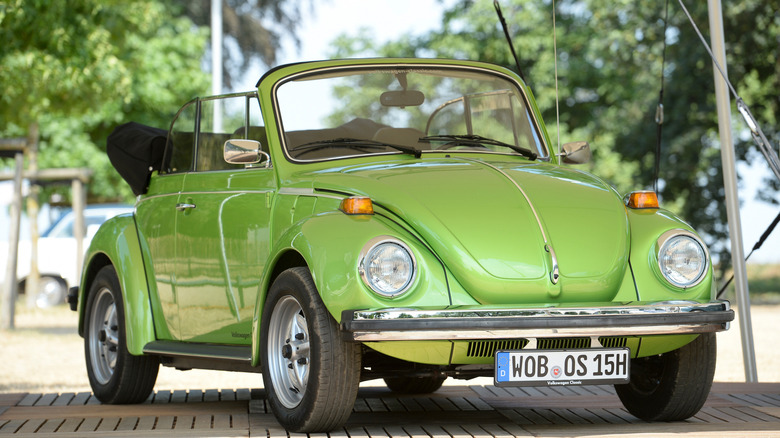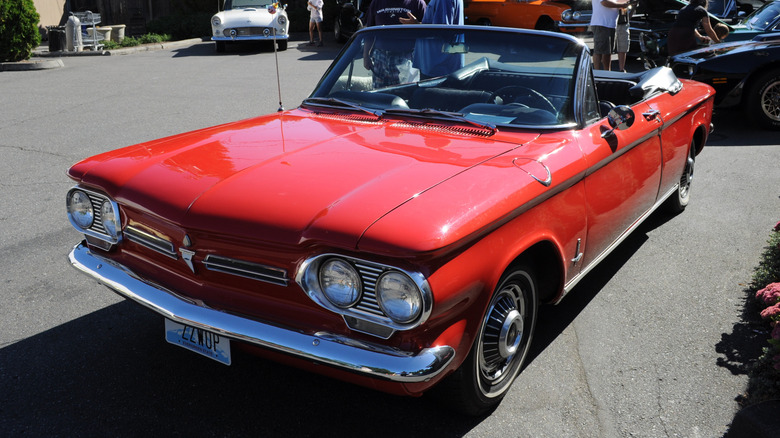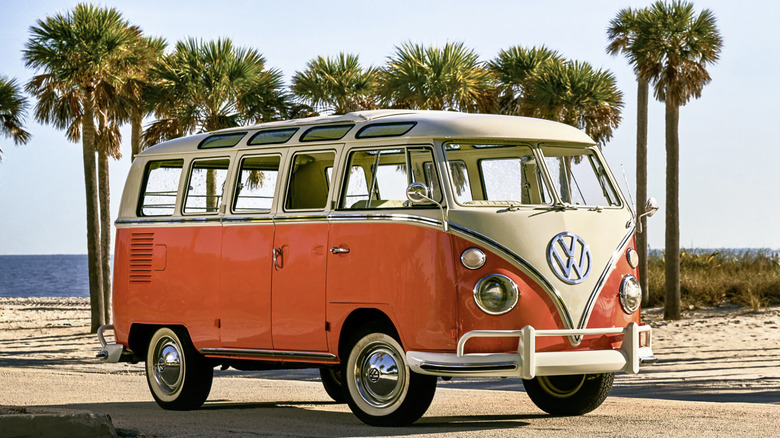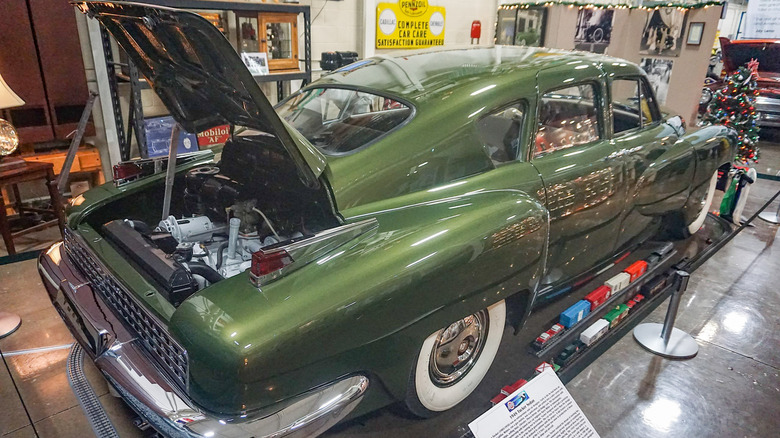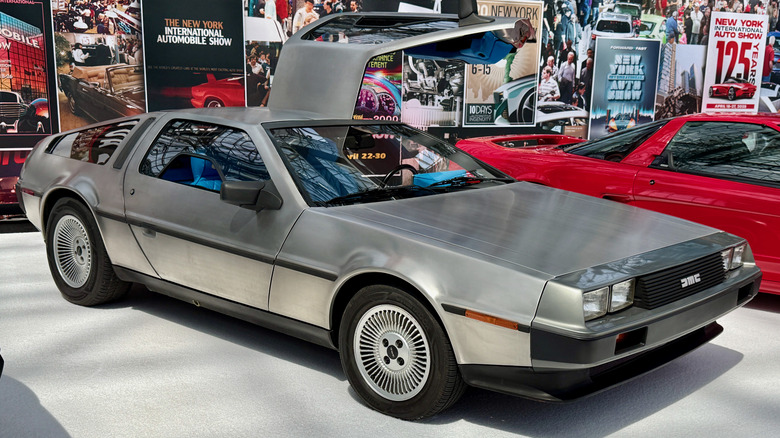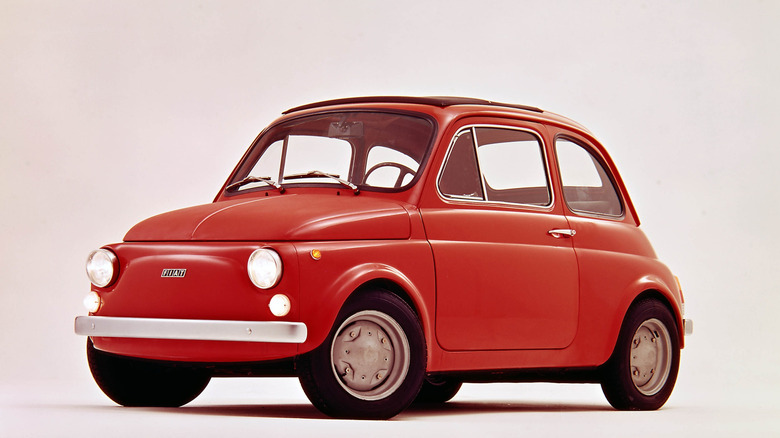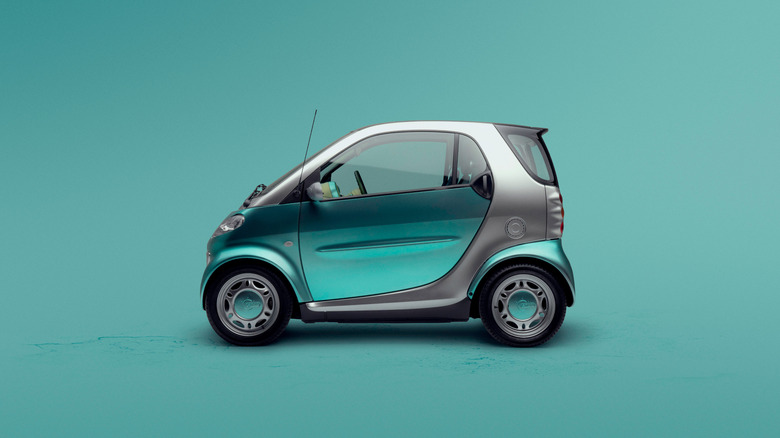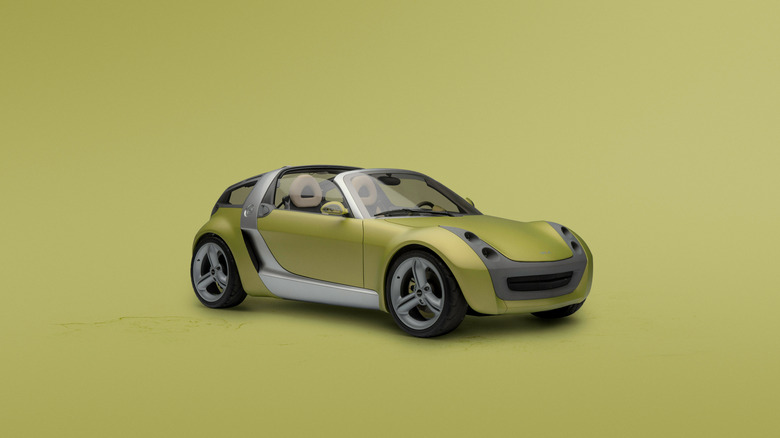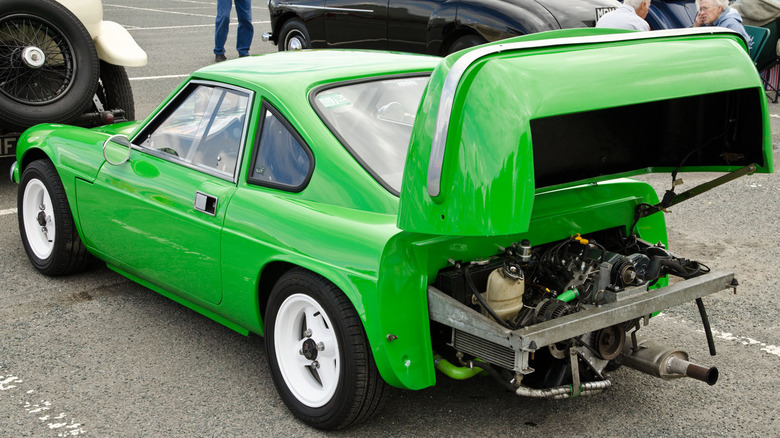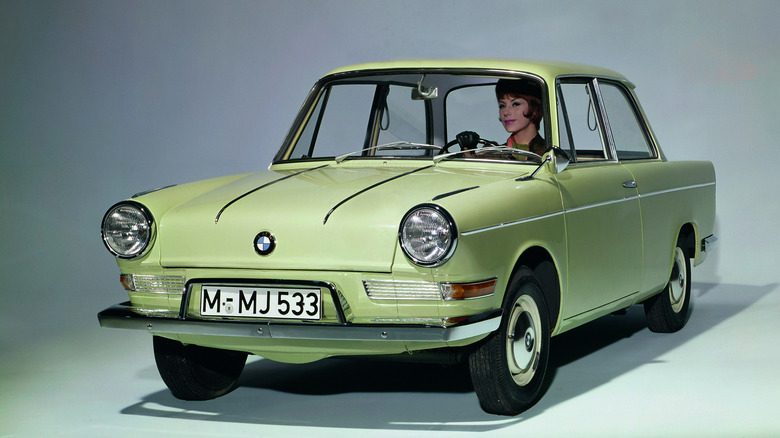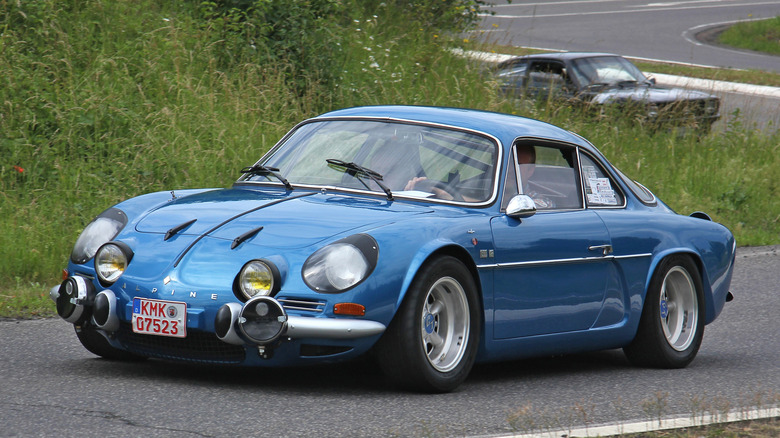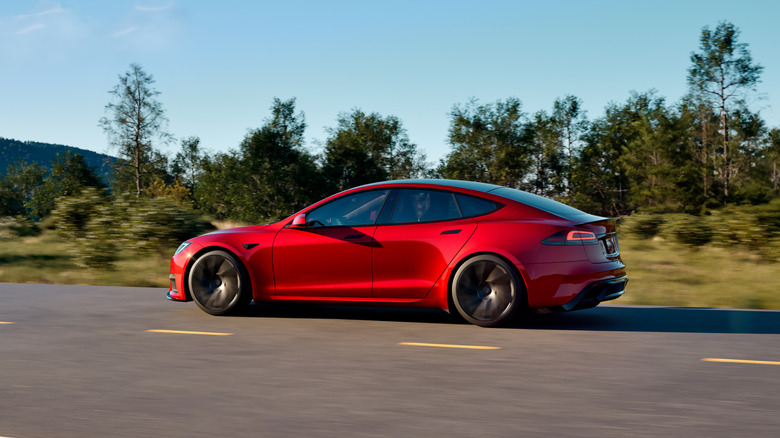13 Cars With Engines In The Back
Rear-engined car models have been rare across automotive history, but many of them are historic and iconic. It's important to understand the difference between mid- and rear-engine placement and how it affects a car. Rear-engined cars have their motors located behind the rear axle, at the very back of the car, while mid-engine cars place theirs just behind the driver and near the center of the car's weight distribution. The vehicles on this list are true rear-engine cars — or a van in one case.
Placing the engine close to the rear axle offers several benefits. It puts more weight on the rear drive wheels, which improves traction for better acceleration. Additionally, without a driveshaft, power is transmitted directly and more efficiently to the rear wheels. There are braking advantages, too, since brake force doesn't shift mainly to the front tires as it does in a front-engine car. Finally, in some small, economy-minded rear-engine cars, this layout was chosen to maximize space in the passenger cabin.
Rear-engine cars have some disadvantages, as well, especially in performance-oriented models. With so much of the weight in the back, they're prone to oversteer, which is a type of skid in which the rear end "fishtails" or slides wide. This can make these cars challenging for inexperienced drivers.
Porsche 911 (1965-present)
One of the world's most famous sports cars has been rear-engined from the start and remains so today. Building on the legacy of the legendary Porsche 356, the 911 debuted in 1965 with an air-cooled, flat-six "Boxer" engine mounted behind the rear axle. This 130-horsepower sports car could hit a top speed of 130 mph. Over the decades, the 911 evolved through targa-topped, "Carrera," and turbocharged models. In 1994, Porsche switched to a 99x naming convention with the 993, but it's also still known as the 911.
The 2025 Porsche 911 Carrera T sports a twin-turbocharged flat-six with 388 horsepower and a 0-60 mph time of 3.1 seconds. There's also a 572-horsepower 911 Turbo with a 2.3-second 0-60 time and a 911 GT3 with 502 horsepower and a 0-60 time as low as 2.8 seconds. In the past, the 911's rear-engine design was infamous for oversteering when drivers backed off the throttle in a corner, making them challenging cars to drive. Subsequent generations of the 911, like the all-wheel-drive Carrera 4 of the early 1990s, became easier to drive fast without having the tail end kick out unexpectedly.
Volkswagen Beetle (1945-2003)
Perhaps the most famous rear-engine car of all time is the original Volkswagen Type 1 Beetle, which remained in serial production for almost six decades, from 1945 to 2003. Beetles were ubiquitous on almost every inhabited continent, and even reached an uninhabited one: In the 1960s, a passel of Beetles made their way to Antarctica. With more than 21 million Type 1 Beetles sold, even some folks who don't know much about cars can tell you that the first-generation Beetle featured an air-cooled engine in the rear.
Several things made the Volkswagen's air-cooled engine so special. For one thing, it required less maintenance than larger, more complicated engines, and when maintenance was needed, it was easy to work on. It was a flat-opposed four-cylinder, making it very compact and freeing up space for the passenger cabin, while its air-cooling system made it cheap to build.
It was never powerful, generating 25 horsepower in the first post-war VWs and 60 horsepower from the 1960s onward. Yet it was easy to give this engine a power boost with a few simple tweaks. With some basic maintenance tips and tricks, owning an old Beetle can be a rewarding experience even for first-time car collectors.
Chevrolet Corvair (1960-1969)
The Chevrolet Corvair was one of the most unusual cars to be produced by a mainstream American carmaker, and one of its quirks was its air-cooled, rear-mounted engine. Of course, the Corvair was also famous for controversy after it featured prominently in Ralph Nader's book, "Unsafe at Any Speed." Yet the Corvair is arguably one of the best examples of cars that don't deserve their bad reputations.
In many respects, the Corvair was a brilliant design right out of the gate with the 1960 model. Chevy introduced this compact car to compete with the increasingly popular Volkswagen Beetle, and it offered a number of advantages over its Teutonic competitor. It featured unibody construction, more interior space, an optional automatic transmission, and a six-cylinder engine — something the Beetle never had.
In the 1960 Corvair, that engine generated 80 horsepower from 140 cubic inches, a decent amount for this little car that barely weighed over 2,300 pounds. Its $2,049 base price was substantially more than the Beetle's $1,565 sticker, but Corvair buyers got quite a bit more horsepower and three-across seating for the extra money. Later Corvair models like the Corsa and the Monza introduced more performance with up to 180 horsepower.
Volkswagen Type 2 (Microbus, 1950-1992)
The Type 1 Beetle was a worldwide sensation for Volkswagen, but its small size ultimately limited its market. Enter the Type 2, also referred to as the Transporter, the Kombi, the Bus, or the Microbus. Introduced in 1950, it followed a similar architecture to its smaller sibling, complete with an air-cooled engine at the back.
This configuration would last through the first three generations (called T1 through T3) of the Type 2, right up to 1992. The 1950 model was powered by a 1.1-liter engine producing just 24 horsepower, but power grew over the years, and the 1992 model featured a 2.1-liter powerplant generating up to 92 horsepower.
The Type 2 became another iconic best-seller for Volkswagen, as well as a classic in its own right. A first-generation 23-window VW bus is rare, and its price today can easily reach six figures. But other models are also highly collectible: A 1965 21-window Deluxe Bus sold at a Barrett-Jackson Auction for an eye-popping $302,500. Not bad for a hippie van!
Tucker 48 (Torpedo, 1948)
The Tucker 48, often called the Tucker Torpedo, beat the Corvair to the rear-engine game by a dozen years. The engine layout was only one of the Tucker's unique features; in fact, the history of the Tucker 48 is a tale of innovations that set it far ahead of its time. Yet the company's founder, Preston Tucker, became embroiled in controversy and fraud charges, and only 51 examples of his "car of the future" were built.
After unsuccessfully trying to shoehorn a 589-cubic-inch flat-six engine into the 48's rear engine bay, Mr. Tucker settled for a water-cooled, opposed six-cylinder engine originally designed for helicopters. Yet this motor was hardly a slouch; its 166-horsepower rating was the most of any American car in 1948. With so much power and weight located so far to the rear of this long car, the 48 is prone to oversteer, although not severely so. The 48's cutting-edge "Torsilastic" suspension helped to keep the vehicle on an even keel.
The Tucker 48's list of auto-industry firsts goes far beyond its helicopter engine. It sported a third, central headlight that swiveled in the direction of steering, along with disc brakes in an era when most other cars had drum brakes. It also offered safety features like a pop-out windshield and a padded dashboard, both of which protected passengers during crashes.
Delorean DMC-12 (1981-1983)
The "Back to the Future" movie franchise turned another troubled car, the DeLorean DMC-12, into one of the most beloved rear-engined cars of all time, although for some contrarians, it's also one of the classic cars they love to hate. The brainchild of John DeLorean, a legendary executive who had worked at Chrysler and General Motors, this futuristic-looking wondercar is known for its stainless steel body and gullwing doors. Yet not all of the car's fans (and haters) realize it's also a member of the rear-engine club.
That rear-mounted engine, alas, was underpowered and arguably the biggest weakness of the DMC-12. It was a 2.5-liter V6 that sent an underwhelming 130 horsepower to the drive wheels via a five-speed manual transmission. On the other hand, the engine was a Peugeot-Renault-Volvo unit, which was appropriate for this international car: Although the DeLorean was an American car, its body was designed in Italy, its suspension was engineered by Lotus in the U.K., and it was built in Northern Ireland.
Like Preston Tucker, John DeLorean wanted his car to be safe, and to that end, he equipped it with dashboard pads for knee and leg protection. Unfortunately, his company suffered a fate similar to Tucker's, collapsing under the weight of legal scandals. He faced drug charges, and although he was acquitted, his company's reputation suffered irreversible damage.
Fiat 500 (1957-1975)
Today's Fiat 500e is an EV, but the original Fiat 500 sported a 479cc, two-cylinder engine at the rear of its diminutive body in 1957. This layout was chosen to save space and maximize the interior volume of the cabin, making this exceptionally tiny car a practical runabout. The air-cooled motor was also mounted transversely to save even more space. The engine was not only small but simple and easy for owners to work on.
Italians of the era were used to maintaining their motorized scooters, so the 500 fit right into their lifestyle. Even for its small size, the car was extra-light thanks to its unibody construction, making it fuel-efficient and nimble. The steering was unassisted, yet surprisingly light, perfect for a city car.
The 1957 500's minuscule engine produced only 13 horsepower, although a later upgrade to a half-liter unit boosted that to 21 horsepower. By 1975, a 594cc unit made 18 horsepower but boosted torque from 22 to 27 lb-ft. Rear-hinged doors were replaced with front-hinged doors in 1965, and fabric sunroofs were available in all model years. The Fiat 500 made our list of the cutest cars ever made.
Smart ForTwo (1998-2019 in the USA)
There are a number of hidden facts about Smart cars for buyers and drivers to be aware of, but one that might surprise a lot of people is this: The Smart ForTwo is a rear-engine little runabout. The product of a collaboration between Nicholas Hayek, the founder of the Swatch watch company, and Mercedes-Benz, the 1998 Smart ForTwo was born out of the realization that most cars on the road have only one or two people on board. To make this tiny two-seater, every space-saving innovation was used.
This included a rear-mounted engine, which allowed the engineers to design a crumple zone into the front of the car. Safety was a major concern, given the Smart ForTwo's tiny size, and the car features a solid steel frame around the passenger compartment.
In 1998, buyers had a choice of 599cc or 799cc three-cylinder engines. By 2016, the available engines included an 89-horsepower, 898cc, turbocharged three-cylinder or a 1.0-liter, 70-horsepower Mitsubishi three-cylinder. Power was adequate for this 106-inch, 2,200-pound car. In 2019, Mercedes announced that the Smart brand was withdrawing from the American market.
Smart Roadster (2003-2006)
Smart followed up on the success of the ForTwo by introducing the Smart Roadster, a 1,851-pound drop-top two-seater with bulging front fenders and a visible, basket-handle structural member arcing behind the seats. It was very eye-catching and reminded many observers of classic British roadsters like the Austin-Healey Sprite or the MG Midget. But unlike those cars, the Smart Roadster kept its engine in the back.
Its transverse-mounted rear engine allowed the Roadster to have a wheelbase slightly longer than that of an MX-5 Miata, with plenty of room for the passenger compartment. With no transmission hump, the cockpit was even more spacious. With its low and sleek nose, however, there was very little luggage space in the front trunk.
The engine was a turbocharged 698cc, Mercedes-built three-cylinder producing 80 horsepower and 81 lb-ft of torque. Even in this featherweight car, this was only good for a 10.7-second 0-60 run. However, like the British roadsters that inspired it, the Smart Roadster's strength lay in its handling: It could pull 0.91 g on the skidpad. Plus, there was the fun-in-the-sun factor after retracting its accordion-like, fully retracting roof.
Ginetta 15 (1968-1974)
Ginetta is a supercar brand you've probably never heard of, but from 1968 through 1974, Ginetta built a road-going, fiberglass-bodied coupe with a Hillman Imp engine in the rear. It was inspired by Ginetta's racing cars and intended for drivers who were willing to work on their own cars and fling them through the curves of country lanes on weekends. Its racing heritage was pretty raw, and this wasn't a car for casual drivers.
The G15 featured an 875cc Hillman Imp Sport engine, although a 998cc engine was optional. The car's exceptionally light weight made up for its small engine displacement, and the G15 would happily reach 85 mph and cruise at that speed effortlessly, or continue on to 100 mph. It also offered tremendous grip and effortless steering, along with a stiff but very competent suspension.
The tail of the car folds up to expose the engine nestled within the subframe. This made it easier to service or fully remove the engine/transaxle assembly. Ginetta sold 800 G15s, some as finished cars, and others as kit cars.
BMW 700 (1959-1965)
The BMW 700 may rank among BMWs that everyone forgot existed, but this small and economical car helped to save BMW during a dark time in the carmaker's history. In the 1960s, BMW was in dire financial straits. The 700 was a sales success, selling more than 180,000 units over the course of the model's lifetime and helping to rescue the company. And it did all this with a rear-engine layout.
At first glance, the 700 looks like a conventional front-engine coupe or convertible. There's nothing overt in its exterior design to indicate that the engine is in the back, as the car has a normal-looking front end until you notice the lack of a grille. This relatively long front end gives the 700 a spacious front trunk, making it a terrific vehicle for weekend getaways. If you open up the back bonnet, you'll find a 697cc, flat-twin, two-cylinder engine. This was based on the BMW R67 motorcycle's engine and had also been used in the BMW 600.
In its initial form, the engine produced 30 horsepower. A Sport version in 1960 came with a 40-horsepower version of that powerplant. Thanks to the car's light weight, this was good for a 78 mph top speed. The low weight combined with a rigid monocoque body to give the 700 spirited handling.
Renault Alpine A110 (1961-1977)
The low-slung and gorgeous Renault Alpine A110 stunned the world by winning the first World Rally Championship. It featured Italian design by Giovanni Michelotti, giving it futuristic looks for its time, and like the Porsche 911, its engine was mounted behind the rear axle. This made it tend toward oversteer, but rally drivers used that to good advantage to slide around corners, much to the delight of onlookers.
The engine in earlier models was a 956cc four-cylinder, but displacement increased in stages until the final competition-spec models ran an 1,800cc version. Along the way, Renault converted the engines to aluminum construction. The A110 was a very light car, so these small engines were more than enough to power it through the curves. The A110 dominated rally car racing until it was overthrown by the Lancia Stratos in 1974. Sadly, the A110's modern successor is one of many great European cars not sold in North America.
Tesla Model S
This one may be a surprise to some, and technically it was a "rear-motor" car rather than a rear-engine car since it was driven by an electric motor, but for much of its history, the Model S was propelled by a single motor at its rear axle. After 2017, the Model S went all-wheel drive with a dual-motor configuration that placed one motor on each axle.
Since its introduction in 2012, the Model S has been a game changer for the automotive industry. Tesla had previously built the Roadster, but that car, while exciting to look at and drive, had limited utility and appeal. The Model S sedan was the first EV with looks, practicality, range, and driving excitement to cross over and appeal to mainstream drivers. Motor Trend named it its 2013 Car of the Year, and Car and Driver named it to its 2016 Ten Best list.
Car and Driver noted that in the 2016 model with the rear-motor, rear-wheel-drive layout, its AC induction motor generates 315 horsepower and 325 lb-ft of torque. Its EPA-rated city/highway fuel economy equivalent was 88 and 101 mpg, achieved with electricity rather than gasoline, of course.
